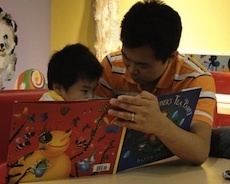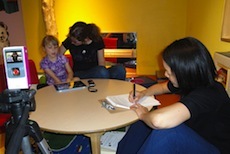
In line with our previous research on coviewing and intergenerational play, the research team at the Joan Ganz Cooney Center wants to get a sense of how interactions between adults and children are taking place when reading electronic books, or e-books. How do adults and children read e-books compared to print books? Is someone more in charge on one format over another? Does one format encourage more conversation between adults and children? Which design features of e-books appear to support parent-child interaction? Do any features detract from these interactions?
In June 2011, we conducted an exploratory study at the New York Hall of Science’s (NYSCI) Preschool Place with 24 pairs of adults (parents, grandparents and caregivers) and children (ages 3-5). We wanted to explore e-book use on the iPad, an increasingly popular platform among families with small children. In our process of choosing which e-books to use for this study (which gave a few of us on the team the opportunity to spend our work days playing on new apps with titles from Dr. Seuss and The Magic School Bus) we came to discover that there are really different standards developing in the levels of interactivity available among e-books. We began to refer to some as enhanced e-books — these are options with bells and whistles like games, videos and interactive characters from the story embedded within a page. Alternatively, basic e-books are print books put into a digital format with minimal features like highlighting text and audio narration. We also found that the majority of e-books that came highly recommended by bloggers and iTunes popularity indexes were incredibly enhanced to the point of resembling interactive movies more than traditional reading experiences. After a long search, we were able to find two titles with science themes that are available in print, enhanced, and basic e-book formats.
Each pair read a print book followed by either an enhanced or basic e-book (and vice versa for half of the sample) while researchers videotaped their interactions and took observational notes. Following the co-reading task, researchers interviewed parents about their reading practices at home and elsewhere. And of course, we had plenty of Sesame Street stickers and coloring books to share with our new literary friends.
Read more about the QuickStudy program.



